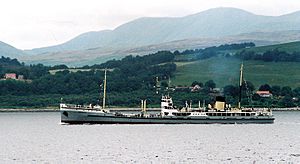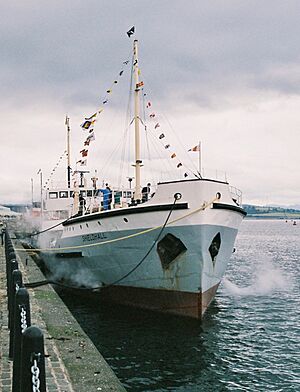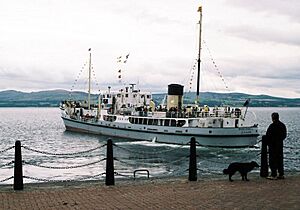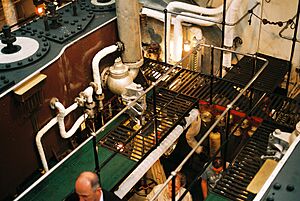SS Shieldhall facts for kids
class="infobox " style="float: right; clear: right; width: 315px; border-spacing: 2px; text-align: left; font-size: 90%;"
| colspan="2" style="text-align: center; font-size: 90%; line-height: 1.5em;" | 
|} The SS Shieldhall is a special steamship that you can visit today. She sails from Southampton, a city in England. This ship used to have a very important job. She was one of the "Clyde sludge boats" in Glasgow, Scotland.
Her job was to carry treated sewage waste from Glasgow. She would travel down the River Clyde and the Firth of Clyde. Then, she would go past the Isle of Arran to dump the waste safely at sea. These steamships were famous for something fun. Since World War I, they would take groups of passengers on their trips during the summer. Today, the SS Shieldhall is a preserved ship. She is used for fun cruises, just like in the old days!
Contents
| History | |
|---|---|
| Name | Shieldhall |
| Owner |
|
| Port of registry | |
| Builder | Lobnitz & Co., Renfrew, Scotland |
| Cost | £291,000 |
| Yard number | 1132 |
| Laid down | October 1954 |
| Launched | 7 July 1955 |
| Completed | October 1955 |
| In service | 16 October 1955 |
| Identification |
|
| Fate | Preserved as Museum ship |
| Status | In service |
| General characteristics | |
| Tonnage | 1,792 GT |
| Length | 81.69 m (268 ft 0 in) |
| Beam | 13.56 m (44 ft 6 in) |
| Draught | 4.11 m (13 ft 6 in) |
| Installed power | 2 triple-expansion steam engines of 800 IHP each |
| Propulsion | Twin screw |
| Speed |
|
| Capacity | 1800 tons of sludge and 80 passengers |
| Crew | 12 |
What is the SS Shieldhall?
The Shieldhall is a large ship, weighing 1,972 tons. Her construction began in October 1954. She was built by a company called Lobnitz & Co. in Renfrew, Scotland. This company also built her two powerful triple expansion steam engines. These engines stand upright, much like the huge engines on the famous RMS Titanic.
By the 1950s, Lobnitz usually built engines with covered parts. But the Shieldhall was made with older-style, open engines on purpose. The city of Glasgow, which owned the ship, allowed passengers to visit the engine room. They wanted people to see the amazing moving parts of the engines while the ship was sailing.
How Was the Ship Designed?
The Shieldhall was designed to look like a classic 1920s steam tanker. She had a traditional wheelhouse, which is where the ship is steered. This part was made using both rivets and welding. She also had a slightly slanted front (called a raked stem) and a rounded back (called a cruiser stern).
The ship is about 268 feet (81.69 meters) long. She is also about 44 feet 7 inches (13.56 meters) wide. There was room for 80 passengers to travel on board. The Shieldhall started her service in October 1955. She was operated by Glasgow Corporation. Her main job was to carry treated sewage waste down the Clyde River to be dumped at sea. People used to jokingly call her and her sister ships "Clyde banana boats." This was because their colors looked like a well-known banana shipping company's ships.
Moving to a New Home
In 1976, after 21 years of working on the Clyde, the Shieldhall was taken out of service. The next year, the Southern Water Authority bought her. Her new job was to carry waste from Southampton, England. She would take it to an area south of the Isle of Wight.
Saving the SS Shieldhall

The cost of fuel became very high, so the Shieldhall stopped working in 1985. After that, a group called The Solent Steam Packet Limited took over the ship. This group is a charity. All the people who work for the charity and on the Shieldhall are volunteers. They don't get paid for their hard work. The other Glasgow waste ships continued working into the 1990s. But then, new environmental rules meant that waste had to be treated differently.
Restoring a Historic Ship
Thanks to the hard work of many volunteers, the Shieldhall has been restored. She is now able to sail at sea again. She is even listed as part of the National Historic Fleet. This means she is a very important historic ship for the country.
The Shieldhall is often seen around the Solent, an area of water near Southampton. She takes people on fun trips. Passengers are welcome to visit the bridge, where the ship is steered. They can also go down to the engine room. This helps them understand what it was like to sail on a steamship in the old days.
The Shieldhall has traveled to other places too. She went to the Netherlands for the Dordrecht Steam Festival. She also attended the International Festivals of the Sea in Bristol and Portsmouth.

In July 2005, the Shieldhall went back to the Clyde River. She took part in the River Festival in Glasgow. She also docked at Custom House Quay in Greenock. From there, she took passengers on cruises along her old route. They sailed down the Clyde to Arran.
In 2012, the Shieldhall was painted to look like the RMS Titanic. This was to mark 100 years since the Titanic sank. In April 2013, the ship received a big grant of £1.4 million. This money helps with important repairs to her hull. It also helps improve things for passengers and teach them more about the ship.
Images for kids



